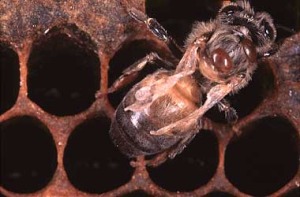Deformed Wing Virus (DWV)
Description
Deformed wing virus (DWV) is a worldwide disease that is often associated with high Varroa mite populations. Like mosquitos, Varroa mites serve as a vector for a whole host of viral diseases, including DWV. Varroa mites, carrying this disease inside them, then infect other bees within the colony as well as honey bees in other colonies due to robbing and drift.
Etiology
Deformed wing virus affects all stages of honey bee development. The severity of this virus greatly depends on the stage in which the individual bee is infected. Individuals infected as adults are asymptomatic and appear normal. Pupae infected in the white eye stage, often make it to adulthood, however, they are malformed and die soon afterward. Brood infected before that time usually die during development.
DWV is one of the few viruses with easily recognizable symptoms. These symptoms are exclusive to the adult honey bee and include: twisted, shriveled wings, bloated abdomens, decreased body size, and discoloration. DWV can also negatively affect learning and memory of infected honey bees.
Spread and Control
Deformed wing virus is most often spread by Varroa mites, which act as a vector for the disease. Due to the correlation between DWV and Varroa mites, the most effect way to treat for DWV is by controlling mite populations within colonies.


